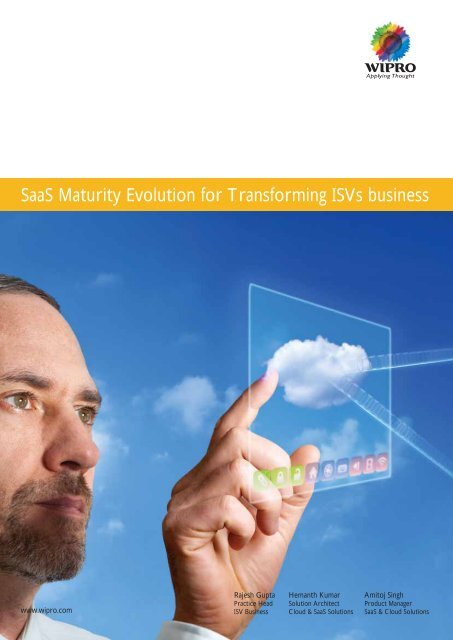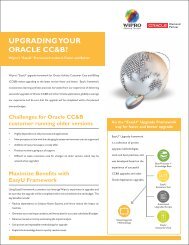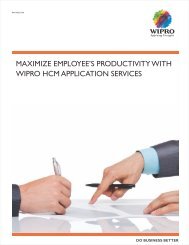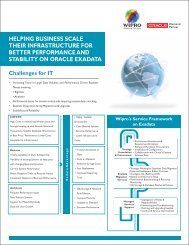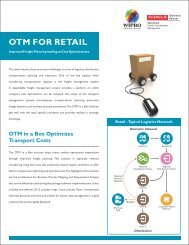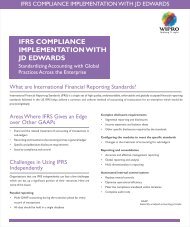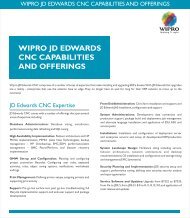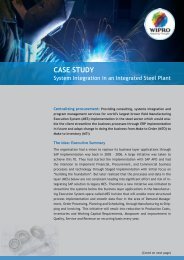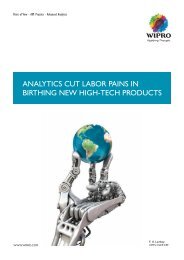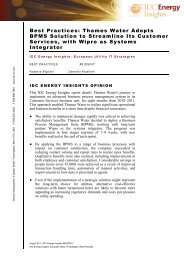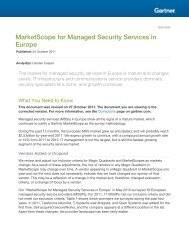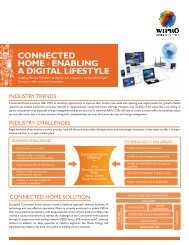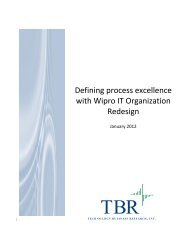Saas Maturity Evolution for Transforming Isvs business
Saas Maturity Evolution for Transforming Isvs business
Saas Maturity Evolution for Transforming Isvs business
You also want an ePaper? Increase the reach of your titles
YUMPU automatically turns print PDFs into web optimized ePapers that Google loves.
SaaS <strong>Maturity</strong> <strong>Evolution</strong> <strong>for</strong> Trans<strong>for</strong>ming ISVs <strong>business</strong><br />
www.wipro.com<br />
www.wipro.com<br />
Hemanth Kumar A. (Solution Architect)<br />
Rajesh Gupta Hemanth Kumar Amitoj Singh<br />
Amitoj Practice Singh Head (Product Solution Manager) Architect Product Manager<br />
Rajesh ISV Business Gupta (Practice Cloud Head) & SaaS Solutions SaaS & Cloud Solutions
Table of contents<br />
03 ................................................................................................................................... SaaS <strong>Maturity</strong> <strong>Evolution</strong> <strong>for</strong> Trans<strong>for</strong>ming ISVs <strong>business</strong><br />
05 ................................................................................................................................... The Three Levels Of <strong>Saas</strong> <strong>Maturity</strong><br />
05 ................................................................................................................................... Faster Go To Market<br />
05 ................................................................................................................................... Customer Centricity<br />
06 ................................................................................................................................... Driving Greater Operational Efficiencies<br />
06 ................................................................................................................................... Summary<br />
02
SaaS <strong>Maturity</strong> <strong>Evolution</strong> <strong>for</strong> Trans<strong>for</strong>ming ISVs <strong>business</strong><br />
ISVs (Independent Software Vendors) have traditionally been using the On-Premise model to deliver their products to<br />
customers. However, with the evolution of Cloud Computing and associated delivery models, software vendors are<br />
considering adopting SaaS/Cloud. For an ISV, SaaS has different levels of maturity which means that SaaS has multiple<br />
functionalities and typically an ISV would need to evolve in the SaaS model following a typical product development life cycle.<br />
The SaaS delivery model promises the consumer a pay-per-use model <strong>for</strong> consuming software without any upfront capital<br />
expenditure in terms of buying the license and infrastructure and without the overhead of maintaining the infrastructure<br />
necessary to run the software. This basically means moving from CAPEX to OPEX. This whitepaper addresses the evolution<br />
of SaaS <strong>Maturity</strong> Model amongst the ISV’s and how they are leveraging the SaaS model to do <strong>business</strong> better. Be<strong>for</strong>e dealing<br />
with SaaS and its implications to <strong>business</strong> at different points in its evolution, however, here is a graphical snapshot of the<br />
3-phased evolution of the SaaS model and what each stage entails.<br />
3<br />
03
S aa<br />
S<br />
M a<br />
t<br />
u rity<br />
L<br />
e v<br />
e ls<br />
There are three levels of SaaS maturity <strong>for</strong> an ISV currently using<br />
“On-Premise” model. An ISV can choose to be in one of these levels<br />
based on the operational efficiency or the resource usage it desires, or on<br />
competitive pressure or on customer demand. An ISV will move from<br />
one level to the subsequent one, based on some of these factors. Also,<br />
based on an ISV’s specific application area such as Engineering/CAD/CAM<br />
Each level brings with it certain attributes at an application/product level<br />
and some at the operational level. Each progressive level encompasses<br />
the application/product and operational level characteristics of the<br />
previous level. At all the three levels, ISV’s face <strong>business</strong> implications;<br />
however the intensity varies from level to level. As the ISV’s move up in<br />
the SaaS maturity evolution, their <strong>business</strong> model is driven by factors like<br />
quicker go to market, customer centricity and greater operational<br />
efficiency.<br />
Hosted Model<br />
(ST - SI)<br />
App level char<br />
config based<br />
customizations<br />
software or Human Capital Management software etc., some of these<br />
levels may never be required. However, this model typically shows a<br />
natural progression <strong>for</strong> SaaS maturity and has, temporarily, ignored the<br />
“Company Strategy” which can alter or restrict movement to a particular<br />
SaaS maturity level.<br />
Hosted + Usage<br />
based Model<br />
(ST - SI)<br />
App level char<br />
License management<br />
integration<br />
metering & billing<br />
Hosted Model<br />
Ops level char<br />
Subscription management<br />
Service catalog &<br />
provisioning<br />
Usage based SLA<br />
management<br />
Hosted Model<br />
Ops level char<br />
Deployment & mgmt. of<br />
multiple instances<br />
Common admin console<br />
<strong>for</strong> VM & App monitoring<br />
Private or 3rd party cloud<br />
On-Premise<br />
End-Customer Demand OR Operational Efficiency OR Competitive Imperativeness<br />
Glossary<br />
ST – Single Tenant SI – Single Instance MI – Multiple Instance MT – Multiple tenants<br />
Hosted + Usage<br />
Isolation of tenants<br />
based Model<br />
(MT - SI/MI)<br />
App level char<br />
Meta-data driven<br />
Single code base<br />
UI, BL, DB level customizations<br />
Tenant isolation<br />
Hosted & Usage model<br />
Ops level char<br />
Load-balanced instances<br />
<strong>for</strong> multi-tenant and<br />
single/multiple instance<br />
model<br />
Hosted & usage model<br />
To begin with, most ISVs are functioning at Level 0 which is the old<br />
model of selling perpetual licenses with yearly subscriptions and annual<br />
maintenance to the customer. However, this is quickly becoming<br />
obsolete with the advent of Cloud computing. ISVs are now better<br />
poised to adopt a higher level of SaaS maturity. The level to which an ISV<br />
moves (0->1 / 0->2 / 0->3) depends significantly on product priorities as<br />
well as company strategy. Although, this model gives ISVs good licensing<br />
04 4
evenue and has been the bread and butter <strong>for</strong> most ISVs, current market<br />
demand pushes them towards adopting a SaaS model (either Level<br />
1/2/3).<br />
The benefits derived by ISV’s from their on demand<br />
products depend on the level of maturity they have<br />
achieved in their SaaS Journey.<br />
The Three Levels Of <strong>Saas</strong> <strong>Maturity</strong><br />
Level 1, the hosted Model is essentially hosting the traditional<br />
single-tenant software as a dedicated instance to every customer. This is<br />
the easiest of the SaaS models. Here the software instance <strong>for</strong> a particular<br />
tenant is separate from an instance used by another tenant. The only level<br />
of sharing here could be the infrastructure. Re-engineering of the<br />
software at this level is not required at all.<br />
In the Level 2 model, the software is still single-tenant and requires a<br />
dedicated instance running <strong>for</strong> every tenant. The only difference here is<br />
that the customer is not required to pay <strong>for</strong> the entire license of the<br />
software. A single license of the software can be shared between multiple<br />
customers in a time-sharing model. The software re-engineering <strong>for</strong> SaaS<br />
is not required.<br />
In the final model at Level 3, the software is completely multi-tenant. This<br />
means that a single running instance of the software can be shared by<br />
multiple customers. The software there<strong>for</strong>e takes care of the necessary<br />
tenant level isolations required <strong>for</strong> multi-tenancy and also could offer<br />
tenant specific customizations at various levels. To host existing<br />
single-tenant software as SaaS in this level of maturity requires<br />
considerable re-engineering ef<strong>for</strong>t. There are some techniques such as<br />
Aspect Oriented Programming which can provide isolation of tenants to<br />
a certain degree and typically provide multi-tenancy.<br />
Faster Go To Market<br />
A simple Hosted SaaS model at Level 1 will serve the purpose of going to<br />
market faster. The customer will benefit from an offering in terms of<br />
reduced maintenance costs as it would be deployed on shared<br />
infrastructure but may still have to pay <strong>for</strong> the complete license of the<br />
software to use it. This is a good entry-level offering <strong>for</strong> a vendor in the<br />
SaaS model, but it is not a sustainable or scalable model. Very soon, the<br />
vendor would be bogged down in managing the multiple customers’<br />
instances on the available infrastructure or would not be able to add new<br />
customers with the available infrastructure running out. The cost of<br />
running the operations in this model is very high once you reach a good<br />
user base. Some of the ISV customers who adopted this model a year or<br />
more ago are now looking at moving to greater SaaS maturity both in<br />
terms of product functionalities and operational efficiencies.<br />
Customer Centricity<br />
The Level 2 model addresses the shortcomings of the Level 1 model. The<br />
Level 2 model is more customer-centric and the vendor is able to provide<br />
more competitive pricing <strong>for</strong> this software with different levels of SLAs.<br />
There is increased level of sharing of the infrastructure and the license,<br />
which reduces the operational cost. The Level 2 model supports<br />
self-provisioning and service catalog <strong>for</strong> the customer offerings. Desktop<br />
as a service delivery model also falls in the hosted and usage based pricing<br />
category and would be a good option <strong>for</strong> many of the Desktop<br />
applications/products. This level requires some integration with the<br />
license management engine of the product to capture correct metering<br />
and usage in<strong>for</strong>mation.<br />
5<br />
05
Driving Greater Operational<br />
Efficiencies<br />
In the Level 3 model, vendor looks to achieve greater operational<br />
efficiency through making the software completely multi-tenant.<br />
Multi-tenant software can help the vendor to optimize the operational<br />
cost to the maximum extent which allows the vendor to offer very<br />
competent usage based pricing <strong>for</strong> the software with various SLAs<br />
This means that a single running instance of the software can be shared<br />
by multiple customers. To host existing single-tenant software as SaaS in<br />
this level of maturity requires considerable re-engineering ef<strong>for</strong>t. At level<br />
3, the software takes care of the necessary tenant level isolations<br />
required <strong>for</strong> multi-tenancy and also could offer tenant specific<br />
customizations at various levels. The end customer, however, may be<br />
oblivious to the fact that the software is multi-tenant, but the level of<br />
customization possible <strong>for</strong> each tenant may be limited.<br />
The level of customization allowed by the multi-tenanted software <strong>for</strong><br />
each tenant will depend on how effectively the single-tenant software<br />
could be multi-tenant enabled. Multi-tenancy also varies at different layers<br />
of software such as Presentation or Business Logic or Database. The cost<br />
of multi-tenant enabling existing software could vary depending on the<br />
architecture of the software, but will have to provide positive ROI within<br />
a short span of time. A possible approach could be use of Multi-tenancy<br />
plat<strong>for</strong>ms using Aspect Oriented Programming or Reverse Proxy and<br />
other techniques <strong>for</strong> multi-tenant enablement of n-tier or web<br />
architecture based products. An alternative approach is always to invest<br />
in engineering ef<strong>for</strong>t <strong>for</strong> fully featured multi-tenancy.<br />
Summary<br />
Each level of SaaS <strong>Maturity</strong> is tied to some operation and application level<br />
attributes. An ISV based on their product roadmap needs to take a<br />
decision whether to move from an On-Premise software to Level 1/2/3<br />
or if they have been using Level 1 then whether to move to Level 2/3.<br />
In the last one year, there have been significant advancements in service<br />
delivery aspects <strong>for</strong> SaaS with the availability of out-of-the box plat<strong>for</strong>ms<br />
that offer some or all of these functionalities:<br />
a) Service catalog and user self-provisioning<br />
b) User authorization, Single Sign-On, users permissions<br />
c) Metering, Billing and usage parameters<br />
d) Shopping cart, order management, Payments & settlements<br />
These out-of-the box plat<strong>for</strong>ms integrate with the ISV products to offer<br />
SaaS <strong>Maturity</strong> of Level 1 and Level 2. Many ISVs are looking at these<br />
plat<strong>for</strong>ms <strong>for</strong> faster migration and significant cost savings. Some of the<br />
ISVs are also looking at developing their products on Public PaaS<br />
plat<strong>for</strong>ms such as Azure or Force.com or GAE. These plat<strong>for</strong>ms provide<br />
some of the functionalities and characteristics inherently required at the<br />
Application/Product level in these public PaaS offerings. However, <strong>for</strong> the<br />
operational aspects might require the use of some of the components of<br />
the out-of-the box third party plat<strong>for</strong>ms. For Level 3, n-tier products<br />
could explore the use of Aspect Oriented programming <strong>for</strong> bringing in<br />
the tenant isolations which is core to the product level multi-tenancy as<br />
an easier method rather than complete re-engineering of the code.<br />
Wipro believes that many of the ISVs would look to adopting out-of-the<br />
box plat<strong>for</strong>ms and techniques such as Aspect oriented programming <strong>for</strong><br />
their SaaS journey <strong>for</strong> their existing products and <strong>for</strong> their new product<br />
development, use Public PaaS plat<strong>for</strong>ms or build a completely SaaS based<br />
product. SaaS evolution has proved to be conducive <strong>for</strong> doing <strong>business</strong><br />
better through faster go to market, greater customer centricity, driving<br />
greater operational efficiencies<br />
6<br />
06
About The Authors<br />
Rajesh Gupta is a practice head <strong>for</strong> ISV <strong>business</strong> responsible <strong>for</strong> providing technology solutions to global software product companies. He has<br />
more than 15 years of Hi-Tech industry experience. He has been instrumental in leading engineering teams, analyzing market needs and<br />
ensuring successful delivery of complex software products. He can be reached at rajesh.gupta@wipro.com<br />
Hemanth Kumar is the Solution Architect from the Business Application Services (BAS) group and has 14+ years of professional experience<br />
in the industry. He has excellent understanding of cloud service delivery requirements and has been involved in architecture and implementation<br />
of a SaaS/Cloud Enablement and Delivery plat<strong>for</strong>m. He is a cloud evangelist and has been actively involved in promoting cloud computing at<br />
various levels. He can be reached at hemanth.aswathanarayana@wipro.com<br />
Amitoj is a part of the Product Management group <strong>for</strong> Cloud/SaaS Solutions in Manufacturing and Hi-Technology Business Unit at Wipro<br />
Technologies. He has been involved in conceptualizing SaaS and Cloud solutions <strong>for</strong> ISVs. He can be reached at amitoj.singh@wipro.com<br />
About Wipro Council <strong>for</strong> Industry Research<br />
Wipro set up the Council <strong>for</strong> Industry Research, comprising of domain and technology experts from the organization, to address the needs of customers.<br />
It specifically looks at innovative strategies that will help them gain competitive advantage in the market. The Council in collaboration with leading academic<br />
institutions and industry bodies studies market trends to equip organizations with insights that facilitate their IT and <strong>business</strong> strategies. For more<br />
in<strong>for</strong>mation on the Research Council visit www.wipro.com/insights or email wipro.insights@wipro.com.<br />
About Wipro Technologies<br />
Wipro Technologies, the global IT <strong>business</strong> of Wipro Limited (NYSE:WIT) is a leading In<strong>for</strong>mation Technology, Consulting and Outsourcing company, that<br />
delivers solutions to enable its clients do <strong>business</strong> better. Wipro Technologies delivers winning <strong>business</strong> outcomes through its deep industry experience<br />
and a 360 degree view of “Business through Technology” – helping clients create successful and adaptive <strong>business</strong>es. A company recognised globally <strong>for</strong><br />
its comprehensive portfolio of services, a practitioner’s approach to delivering innovation and an organization wide commitment to sustainability, Wipro<br />
Technologies has over 120,000 employees and clients across 54 countries.<br />
For more in<strong>for</strong>mation visit www.wipro.com.<br />
07
DO BUSINESS BETTER<br />
www.wipro.com NYSE:WIT | OVER 120,000 EMPLOYEES | 54 COUNTRIES | CONSULTING | SYSTEM INTEGRATION | OUTSOURCING<br />
Wipro Technologies, Doddakannelli, Sarjapur Road, Bangalore - 560 035, India. Email: info@wipro.com, Tel: +91 (80) 2844 0011, Fax: +91 (80) 2844 0256<br />
North America Canada Germany Switzerland Austria Finland Portugal Japan Singapore South America United Kingdom France Poland Sweden Benelux Romania Philippines Malaysia Australia China South Korea New Zealand<br />
©Copyright 2011. Wipro Technologies. All rights reserved. No part of this document may be reproduced, stored in a retrieval system, transmitted in any <strong>for</strong>m or by any means,<br />
electronic, mechanical, photocopying, recording or otherwise, without express written permission from Wipro Technologies. All other trademarks mentioned herein are the<br />
property of their respective owners. Specifications subject to change without notice.


